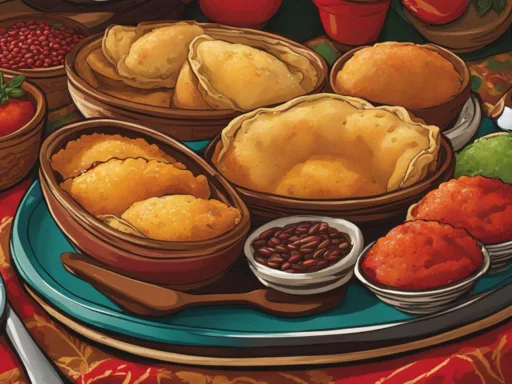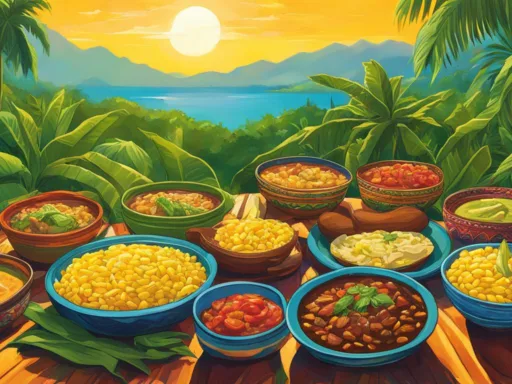When it comes to Swiss food culture, many might merely envision the smooth, decadent chocolates and the velvety cheese that melts in a pot of fondue. But is that really the full extent of the Swiss culinary canvas? As you embark on this Swiss Food Journey, prepare to delve into the heart of Swiss cuisine that offers a sumptuous blend of traditional Swiss dishes, each telling a tale of Switzerland’s diverse cultural influences and pastoral legacies.
Whether it’s savoring the rich nuances of a chocolate truffle or warming your spirit with a comforting pot of raclette, the gastronomic adventures that define Swiss food culture are as layered as the country’s Alpine landscapes. So, let’s explore beyond the clichéd treats and uncover the true breadth of flavors that Swiss cuisine has been perfecting for centuries.
Key Takeaways
- Swiss Food Journey reveals much more than internationally famed chocolates and cheeses.
- Discover how the convergence of French, German, Italian, and Romansh cultures enriches Swiss cuisine.
- Traditional Swiss dishes reflect a deep-seated passion for culinary art and quality produce.
- Swiss food culture champions not only its hearty dishes but also delicate pastries and robust wines.
- Every bite in Switzerland is an invitation to appreciate the complex tastes and diversity of Swiss gastronomy.
The Melting Pot of Switzerland’s Culinary Scene
Switzerland’s reputation for famous Swiss foods is not just built on its rich chocolates and decadent cheeses—its true essence lies in the country’s regional recipes and flavors that tell a story of Swiss heritage. This gastronomic diversity is a palatable illustration of the different languages and cultures that coexist within Switzerland’s borders. For those seeking Swiss culinary experiences, the journey is as scenic as the Alpine landscape, offering a taste of authentic Swiss food at every turn.
From the sizzling fondue pots of Vaud to the robust flavors of air-dried meats in Grisons, Swiss cuisine reflects the heartening diversity of its cantons. Each region preserves its unique culinary identity, whether it’s the sumptuous layers of flavor in a Zurich schnitzel or the contrast of the nutty, tangy raclette against the simple, rustic appeal of potatoes turned golden and crunchy as a roesti.
| Canton | Culinary Specialty | Description |
|---|---|---|
| Vaud | Fondue | A communal dish where bread is dipped into melted cheese, perfect for sharing and socializing. |
| Grisons | Bündnerfleisch | Air-dried meat that is typically enjoyed with regional wine. |
| Bern | Röesti | A potato dish often likened to hash browns, crispy on the outside and soft on the inside. |
Switzerland’s picturesque culinary scene is not just a medley of tastes but also an odyssey that reflects the country’s long-standing traditions. It’s a place where the aroma of buttery pastries wafts through the morning air and where every bite of a hearty meal seems to wrap you in the warmth of Swiss hospitality. With every dish served, there’s a sense of pride in its authenticity—a taste of the passion and history behind Switzerland’s rich dietary culture.
Embark on a Swiss Food Journey: From Cheese to Chocolates
Swiss food culture presents a palette of flavors that take epicureans on a delightful journey through traditional Swiss dishes. Renowned for concocting meals that provide both warmth and satiation, the culinary offerings range from gooey cheese to the smoothest chocolates. Each meal is a testimony to Swiss food specialties, delivering tastes that have evolved through centuries of culinary tradition.
Traditional Swiss Dishes that have been savored by generations form the heart of local cuisine. Fondue, a sociable dish, gathers people around a pot of melting cheese heaven, while raclette brings forth its velvety cheese draped over potatoes and pickles. The ubiquity of potatoes in Swiss cooking is best exemplified by rösti, a crispy potato pancake often served as a hearty side.
| Dish | Main Ingredients | Typical Occasions |
|---|---|---|
| Fondue | Emmental and Gruyère cheeses, garlic, wine | Cold winter evenings, social gatherings |
| Raclette | Raclette cheese, potatoes, pickled onions | Dinner parties, traditional celebrations |
| Rösti | Potatoes, butter or oil, salt | National Day, as a side with meats |
In Zurich, the beloved Zurich-style veal highlights the Swiss penchant for combining creaminess with the richness of meat, creating a dish that is beloved across borders. As for satisfying the sweet tooth, the art of baking emerges in butterzopf, a buttery braided bread, and the world-renowned Swiss chocolates that melt seamlessly on the tongue, symbolizing the pinnacle of Swiss confectionery skills.
From the symphony of melted cheese to the allure of decadent chocolates, every traditional Swiss dish presents a tableau of the nation’s rich history and culinary finesse.
A stroll through Swiss food specialties is incomplete without acknowledging the craftsmen behind the scenes. Swiss cheesemakers and chocolatiers are ambassadors of an age-old craft, each adding their signature touch to create flavors that resonate with the essence of Switzerland. As a diners’ paradise, the country invites you to indulge in its storied gastronomic narrative, promising an experience that lingers beyond the last morsel.
Tradition Meets Modernity: The Evolution of Swiss Cuisine

As a nation cradled amidst the Alps, Switzerland is a land where traditions hold steadfast and modern influences are embraced with thoughtful integration, especially when it comes to gastronomy. The Swiss Food Journey is a tantalizing trek through time-honored practices and contemporary flair. In the heart of Europe, Swiss cuisine has become a melting pot of flavors, maintaining its unique identity while reflecting the multicultural embrace.
The Influence of Neighboring Cultures on Swiss Cuisine
Certainly, no Swiss Food Journey could ignore the subtle and sometimes bold flavors borrowed from neighboring France, Germany, and Italy. These influences have permeated Swiss kitchens, leading to a harmonious blend in the country’s culinary repertoire. The crossover is celebrated in the best Swiss food restaurants where chefs delight patrons with dishes that are both familiar and novel, testimony to the shared history and continued cooperation between these culturally rich nations.
The Resilience of Swiss Culinary Traditions Over Time
Despite global trends leaning towards fast food and convenience meals, Swiss cuisine has preserved its integrity. Traditional dishes remain the spine of Swiss gastronomy. The resilience of these recipes is evident by the frequent sights and smells of cheese fondue and raclette in local eateries, offering a window to the past through each savored bite. It is this steadfastness that marks Swiss cuisine as a beacon of culinary heritage, respected worldwide.
True connoisseurs seeking to understand Swiss culture embark on this culinary odyssey hoping to find where tradition meets modernity on a plate. From the century-old recipes brought to life in the mountainous cantons to the innovative twists added in urban gastronomic hubs, Switzerland seals its reputation as a custodian of its own food legacy while keeping an open door to contemporary tastes.
| Traditional Swiss Dish | Modern Interpretation | Region of Origin |
|---|---|---|
| Fondue | Fondue with exotic cheeses | Vaud |
| Raclette | Raclette with charcuterie ensemble | Valais |
| Rösti | Rösti with smoked salmon | Bern |
| Zürcher Geschnetzeltes | Veal strips in a mushroom cream sauce | Zurich |
In essence, the journey through Swiss cuisine is much like the country’s landscapes: filled with peaks and valleys of flavors where each hillside and each lake tells a different tale. The Swiss Food Journey is ripe for discovery, offering a delectable path from the pastoral to the urban, from the comfortingly traditional to the thrillingly new.
Sampling Switzerland’s Traditional Dishes
A taste of Switzerland’s authentic fare is as rich and varied as its landscapes. Embarking on a voyage through Swiss food specialties is to delve into a culinary tradition steeped in history and flavor. Below, three cherished dishes form the cornerstone of Swiss culinary experiences, each offering a distinct indulgence for the senses.
Fondue: The Quintessential Swiss Experience
The mere mention of fondue conjures images of comfort and camaraderie. Fondue is more than a meal; it is a communal journey through the warmth of Swiss hospitality. The dish’s heart is a bubbling cauldron of creamy cheeses, typically Gruyère and Emmental, inviting diners to dip and share with every soft bread bite. It’s no wonder that fondue is celebrated as a cherished Swiss food specialty, emblematic of the country’s culinary spirit.
Rösti: A Crispy Potato Specialty
For an experience of the Swiss palette’s simpler side, look no further than rösti. This grated potato delicacy, crisped to perfection in a frying pan, is the essence of comfort food in the Swiss cantons. Originally a breakfast dish for farmers in the canton of Bern, rösti has since become a beloved feature throughout Switzerland, perfect for pairing with a variety of accompaniments, or enjoyed gloriously on its own.
Zürcher Geschnetzeltes: Zurich’s Renowned Veal Dish
Zürich claims its fame in the Swiss culinary scene with Zürcher Geschnetzeltes, finely sliced veal enveloped in a creamy mushroom sauce. Paired traditionally with rösti, this rich entrée showcases the seamless marriage of delicate meat textures and robust flavors that are a hallmark of Swiss gastronomy.
Below is a table highlighting the essential characteristics that make these dishes stand tall among Swiss food specialties:
| Dish | Main Ingredients | Region of Origin | Perfect Pairing |
|---|---|---|---|
| Fondue | Emmental and Gruyère cheeses | Western Switzerland | Crusty bread, pickles, and small potatoes |
| Rösti | Potatoes | Bern | Smoked sausages or cured meats |
| Zürcher Geschnetzeltes | Veal, mushrooms, onions, cream | Zürich | Rösti or buttered noodles |
Indulging in these dishes is akin to taking a savory stroll through Switzerland’s rich heritage—a must for any epicurean embarking on a Swiss culinary experience.
Exploring Regional Swiss Cuisine: A Cantonal Discovery
Swiss food culture, with its distinct regional Swiss cuisine, offers a palette of flavors that range from hearty alpine dishes to the rich and creamy delights influenced by bordering nations. In this section, we delve into the authentic Swiss food specialties that have been preserved and cherished in the cantons of Ticino and Vaud.
Indulging in the Flavors of Ticino
Bordering Italy, Ticino is Switzerland’s southernmost region, where the influence of Italian cuisine is strong and celebrated. Here, gastronomy enthusiasts indulge in the bold flavors and simple yet satisfying dishes that define true Ticino dining experiences.
The Culinary Heritage of Vaud
In the canton of Vaud, located in the heart of the Swiss Romandy, the culinary offerings are a testament to the Swiss affinity for blending the lake’s bounty with traditional agricultural produce, crafting plates that tell the tale of Vaud’s opulent culinary heritage.

| Ticino Specialties | Vaud Specialties |
|---|---|
| Risotto | Filets de Perche |
| Polenta | Papet Vaudois |
| Minestrone | Tomme Vaudoise |
| Osso Buco | Meringues with double cream |
Embarking on a journey through Ticino and Vaud is not only a treat for the senses but an enriching experience that adds depth to one’s understanding of the Swiss food culture. It’s a discovery of the country’s gastronomic diversity, from the sun-kissed valleys of Ticino to the serene lakeshores of Vaud.
Cheese: The Heartbeat of Swiss Gastronomy
A Swiss Food Journey isn’t complete without indulging in the rich tapestry of Swiss cheese varieties that are central to many famous Swiss foods. The love for cheese is a theme woven into the very fabric of Swiss cuisine, finding expression in beloved dishes that delight both locals and international food lovers alike. Whether melted into a pot of fondue or gently grilled in a raclette pan, these cheeses capture the pure essence of Swiss gastronomic culture.
In the rolling hills and quaint villages of Switzerland, cheese is more than just food; it’s a cultural symbol, a culinary staple, and an art form revered by connoisseurs and casual diners alike.
Particularly renowned are the likes of Emmental, Gruyère, and Appenzeller. These cheeses, respectively known for their nutty, sweet, and slightly spicy flavors, illustrate the diversity and expert craftsmanship of Swiss cheesemakers. Beyond these, other varieties such as Tête de Moine, Vacherin, and Sbrinz contribute unique textures and flavors to the Swiss cheese mosaic.
- Emmental: Famous for its large holes and mild, creamy taste.
- Gruyère: A smooth-melting cheese with a slightly sweet, complex flavor.
- Appenzeller: Known for its herbal brine surface and semi-hard texture.
- Tête de Moine: Formed into delicate rosettes with a distinct aromatic texture.
- Vacherin: Often used in baking and has a soft, melt-in-your-mouth texture.
- Sbrinz: A hard cheese that’s enjoyed either sliced or grated.
Each variety of Swiss cheese plays a pivotal role in the dining experience, from the first course to the last. The artistry in their creation and versatility in their use make them staple components in traditional recipes and cutting-edge culinary innovations. They underscore the seamless blend of heritage and invention that marks the Swiss food journey.

As you traverse the landscape of Switzerland, the journey through its cheese offerings tells a storied past, highlights local craftsmanship, and delights the palate. A survey of these flavors is not just about tasting cheese; it’s about connecting to a rich Swiss heritage that’s as enduring as the Alps themselves. Whether consumed within Switzerland’s borders or savored across the globe, Swiss cheese remains the edible ambassador of Swiss gastronomy, keeping the traditions, craftsmanship, and renowned flavors alive for each new generation to cherish.
Swiss Bakery and Confectionery Artistry
The craftsmanship within Swiss bakery and confectionery is a testament to the country’s rich culinary heritage. Recognized for an array of delectable Swiss bakery products and the revered Swiss chocolate production, Switzerland’s reputation for sweet excellence is well-earned. This artisan mastery is a blend of tradition and meticulous attention to detail, savored in every bite.
Sweet Indulgences: Swiss Pastries and Chocolates
In the realm of Swiss confectionery, the dedication to premium ingredients and refined textures shines through in desserts like the flaky züpfe and the rich nusstorte. Swiss pastries aren’t just treats; they’re culturally significant artworks passed down through generations. An integral part of this tradition is celebrated through Swiss chocolate production, renowned for its silky-smooth quality and complex flavor profiles—a result of the time-honored techniques and innovation in the field.
Artisan Breads: A Taste of Swiss Tradition
Switzerland’s bread culture presents a plethora of varieties, each with its own story. From the braided buttery strands of butterzopf and festive grittibänz to the hearty rye of pain de seigle, the assortment of Swiss bakery products offers a peek into the country’s diverse food landscape. The reverence for artisan bread-making is an integral thread in the Swiss culinary fabric, tying the nation’s community and history to its present gastronomic achievements.
| Swiss Bakery Product | Description | Region of Origin |
|---|---|---|
| Butterzopf | Braided buttery bread, often enjoyed on weekends | Throughout Switzerland |
| Nusstorte | Short crust pastry with a caramelized nut filling, typically walnuts | Engadin, Graubünden |
| Pain de seigle | Dense rye bread with a robust flavor, served with cheese or dried meats | Valais |
| Grittibänz | Bread shaped like a little man, traditionally made for St. Nicholas Day | German-speaking regions |
| Züpfe | A type of plaited white loaf, similar to butterzopf | Bern |
Switzerland’s Liquid Gold: Wines and Beverages
Within the heart of Europe, Swiss food culture is celebrated not only for its hearty meals but also for its exceptional beverages. From the terraced vineyards gazing down the serene lakes to the rustic cellar doors nestled in Alpine villages, Switzerland is a lesser-known, yet enchanting, wine-producing nation. Sipping on robust wines becomes an integral part of Swiss culinary experiences—each glass a narrative of the local terroir.
Switzerland’s vintners, with their profound respect for the environment, craft wines that are as varied as the country’s languages. One may find the crisp and aromatic Chasselas in Vaud, or the full-bodied Merlot in Ticino, each region offering a signature wine that splendidly complements local dishes. These wines, often enjoyed alongside a meal of raclette or fondue, are the perfect testament to the harmony between Swiss cuisine and viticulture.
Celebrating the art of viticulture, Swiss wines hold an esteemed place on the global stage, offering a sip of tradition and innovation in every glass.
Among the popular Swiss beverages, the mulled wine known as Glühwein takes center stage during the winter season, its spiced warmth reflecting Switzerland’s festive spirit. Meanwhile, the country’s fruit brandies and herbal liqueurs offer a different dimension to the Swiss palate, often served as a digestif to round off a sumptuous meal.
Not to be overlooked, Switzerland’s commitment to non-alcoholic beverages is equally notable. The apple must, a fresh apple cider, is a favorite among locals, especially when enjoyed fresh from a highland orchard.
- Chasselas – Vaud’s Wine of Light
- Merlot – Ticino’s Robust Red
- Glühwein – Alpine Winter’s Delight
- Fruit Brandies – The Essence of Orchards
- Herbal Liqueurs – Digestives with a Swiss Twist
- Apple Must – The Alpine Nectar
Indeed, any narrative on Switzerland’s gastronomy would be incomplete without a toast to its vineyards and the wide array of beverages that define Swiss dining. As enthusiasts venture through Switzerland, they not only indulge in fine cuisine but also discover that wine and traditional drinks play an essential role in the Swiss ethos of hospitality and celebration.
Redefining Swiss Cuisine: Modern Gastronomic Innovations
The landscape of modern Swiss gastronomy is undergoing a significant and palatable change. In Switzerland today, a culinary revolution thrives – one steeped in heritage yet brimming with innovative approaches to dining. This vanguard is championed by local chefs and the emerging farm-to-table sensibility, marrying the time-honored traditions of Swiss cooking with cutting-edge food trends and sustainable practices.
Swiss Chefs Leading the Culinary Revolution
Swiss chefs are at the forefront of the culinary innovation scene, delicately fusing time-honored Swiss recipes with avant-garde techniques. They’re committed to showcasing the wealth of Switzerland’s produce through their inventive dishes, resulting in a fresh and modern twist on beloved classics. These artisans of taste are reshaping the way we think about Swiss food experiences, moving from the fondue pot into the realms of gourmet cuisine that’s both grounded in tradition and elevated by creativity.
Farm-to-Table Movement in Switzerland
Parallel to these chefs’ endeavours is the rising prominence of the farm-to-table movement within Switzerland. This ethos emphasizes the intimate connection between the farmer’s fields and the gastronome’s table. Seasonality and locality are not merely buzzwords here; they are principles that drive the procurement of the freshest ingredients directly from the source. This movement supports not just gastronomic excellence, but also ecological responsibility and sustainability, reinforcing Switzerland’s commitment to conscious consumption and environmentally aware culinary innovation.
Together, Switzerland’s culinary artists and the proponents of farm-to-table dining articulate a vision for Swiss cuisine that is as rich in flavor as it is in principled practice. They ensure that each meal is not just a transaction, but a transformative experience reflecting the essence of modern Swiss culture.
Conclusion
Our Swiss Food Journey culminates in a profound understanding of a country that wears its heart on its platter. Switzerland’s vibrant food culture is an illustration of history, innovation, and a boundless love for gastronomy. Traditional Swiss dishes such as cheese fondue, rösti, and Zurich’s renowned veal speak volumes of the nation’s culinary expertise. Every bite of these Swiss food specialties transports the discerning gourmand to the Alpine pastures and the country’s festive spirit.
The commitment to maintaining a rich Swiss food culture is mirrored in the careful craft of Swiss chocolatiers and the ingenuity of Swiss bakers whose hands shape the pastries and breads defining the nation’s mornings. The harmonious blend of traditional practices with modern interpretations by gifted Swiss chefs showcases a dynamic gastronomy constantly evolving while staying true to its roots.
Stepping into the realm of Swiss cuisine is to embark on an adventure beyond mere flavors. It is to participate in a cultural ritual that brings people together, sharing in the delight of Swiss food specialties that are as inviting as the country’s verdant landscapes. Truly, every dish is not just a meal; it’s a narrative of Switzerland’s unyielding spirit and an invitation to appreciate the splendor of its culinary heritage.
FAQ
What are some must-try traditional Swiss dishes for travelers?
Travelers should not miss the chance to enjoy fondue, raclette, rösti, Zürcher Geschnetzeltes, and various Swiss pastries such as nusstorte along their Swiss food journey. Each dish offers a unique taste of Swiss culinary culture and heritage.
How does Swiss cuisine reflect the country’s cultural diversity?
Swiss cuisine is heavily influenced by France, Germany, Italy, and Romansh cultural traditions, resulting in a rich tapestry of flavors and dishes unique to each region. From the Germanic rösti to the Italian-influenced risotto of Ticino and the French savory fondue, Swiss food culture is truly a melting pot of diverse culinary traditions.
Where can I find the best authentic Swiss food?
Authentic Swiss food can be best experienced in local restaurants and inns across the country, which specialize in regional Swiss cuisine. Visiting cantonal areas such as Vaud, Grisons, Bern, and Ticino will offer opportunities to taste dishes that are traditional to those regions.
What are the key ingredients in Swiss cuisine?
Cheese and potatoes are staples in Swiss cooking, with various Swiss cheese varieties such as Emmental, Gruyère, and Appenzeller taking a central stage. Other key ingredients include high-quality meats, fresh lake fish, and a variety of grains for traditional Swiss bakery products.
What makes Swiss chocolate and pastries unique?
Swiss chocolate and pastries are renowned for their high-quality ingredients and the meticulous craft of Swiss confectioners. The careful selection of cocoa beans and precise chocolate-making techniques result in products that are appreciated worldwide for their superior taste and texture.
Can you recommend any Swiss wines to complement traditional dishes?
Switzerland produces a variety of robust wines that beautifully complement its traditional dishes. Depending on the meal, you might want to try a crisp white wine such as Chasselas with fondue or raclette, or a Pinot Noir with meat-based dishes like Zürcher Geschnetzeltes.
Are there modern interpretations of Swiss cuisine for those interested in culinary innovation?
Swiss cuisine has evolved with time, and now many chefs are reinterpreting traditional recipes through modern techniques and a focus on local, seasonal, and sustainable ingredients. Restaurants spearheading this culinary innovation provide a contemporary Swiss dining experience while maintaining the essence of Swiss gastronomy.
How has the farm-to-table movement impacted Swiss food culture?
The farm-to-table movement in Switzerland has led to an increased emphasis on the origins of food and sustainability practices. It has fostered a greater appreciation for local produce and artisanal Swiss food specialties, marrying eco-consciousness with culinary enjoyment.
What role does cheese play in Swiss gastronomy?
Cheese is fundamental to Swiss gastronomy and appears in many iconic Swiss dishes, such as fondue and raclette. Swiss cheeses are celebrated for their variety and quality, often derived from age-old cheesemaking traditions and forming a core part of the nation’s culinary identity.
How can I experience Swiss culinary traditions during my visit?
To immerse yourself in Swiss culinary traditions, participate in food tours, cooking classes, and wine tastings which are available throughout Switzerland. Seasonal festivals and markets also provide a glimpse into Swiss food culture, offering a range of Swiss food specialties to savor.






